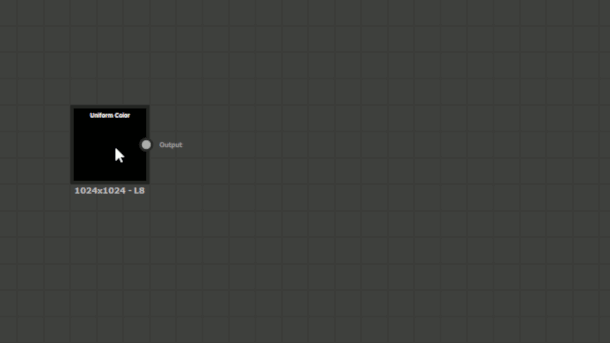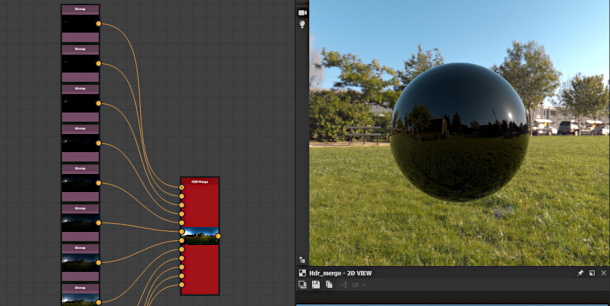Adobe ships Substance Designer 2019.2

Originally posted on 30 July 2019. Scroll down for news of the commercial release and new HDRI tools.
Adobe has previewed some of the upcoming features in Substance Painter 2019.2, the next update to its material-authoring software, including improvements to the node graph and MaterialX support.
The features were unveiled at Substance Days, the firm’s user event at the start of Siggraph 2019, alongside Project Anorigami for Substance Painter and a new free trial edition of Substance Alchemist.
The release will be the first update to Substance Designer fully under Adobe’s branding, following its acquisition of original developer Allegorithmic earlier this year.
Workflow improvements to the node graph
The next release of Substance Designer – on its blog, Adobe refers to it as the ‘Summer 2019’ update, but if it sticks to its current version numbering, it will be version 2019.2 – extends the software’s node graph.
The update adds a new Dot node, described as acting as a pass-through between parts of a node network.
Users can add multiple Dots to create custom paths between nodes, enabling them to organise node graphs in new ways.
Workflow improvements include the option to display the node drop-down menu while dragging out a link to create a new node, as shown above; plus filtering and favorites within the drop-down itself.
Other changes: improved OpenGL view, performance improvements
Substance Painter 2019.2 will also update the software’s viewport, with support for anisotropy and clearcoat materials in the OpenGL view.
Performance improvements include optimisations to Substance Designer’s asset library: according to Adobe, it should be possible to “see your shelf two to six times faster”.
Adobe’s round-up of upcoming technologies in its Substance tools. Skip to 01:45 for Substance Designer.
Support for the MaterialX standard for rich material data
The update will also introduce support for MaterialX, Industrial Light & Magic’s open standard for exchanging rich material data beween DCC applications.
The video above, which rounds up work-in-progress features across Adobe’s entire set of Substance tools, shows MaterialX in use to transfer materials between Substance Designer and Substance Painter.
In addition, the format is supported in Arnold and features on Autodesk’s roadmap for 3ds Max.
The video also shows a new dual viewport system within Substance Designer: one viewport using MDL, Nvidia’s Material Definition Language, the other using OpenGL’s GLSL shading language and MaterialX.
According to Adobe, the feature is still a prototype, but should make it possible to export both MDL and MaterialX materials from a single node network.

Updated 30 August 2019: Substance Designer 2019.2 is shipping. As well as the features covered above, the update introduces a new set of tools for creating HDR maps.
New nodes include HDR Merge, shown above, which merges multiple LDR images to a single HDR image, and Nadir Patch, intended for cloning out tripods and camera rigs from the source images.
There are also tools for editing the resulting HDRI environment map, including new nodes for rotating or repositioning the environment, straightening the horizon or adjusting colour temperature.
Users can also export a planar ground texture from the spherical HDRI.
Other features include the option to add synthetic Plane, Line and Spehere lights to a HDR lighting setup by positioning them in a 2D view: a workflow that will be familiar to users of HDR Light Studio.
Substance Designer 2019.2 also adds a new physical sun and sky system based on the Hosek-Wilkie model.
In addition, the implementation of the Iray render engine within Substance Designer now supports Nvidia’s new RTX GPUs, although Adobe hasn’t put a figure on the resulting performance boost.
However, one feature not listed in either Adobe’s latest blog post or the online release notes is MaterialX support. We’ve contacted the firm to ask whether it has actually made it into the release.
Updated 6 September 2019: Adobe has confirmed that MaterialX support is not in the current release, though it is “still in the pipeline”.
Pricing and availability
Substance Designer 2019.2 is available for Windows 7+, CentOS 7.0 or Ubuntu 16.04 Linux and macOS 10.12+.
New Indie licences of the software, intended for artists and studios earning less than $100,000 per year, cost $149; Pro licences cost $990. Both prices include 12 months’ maintenance.
Read an overview of the new features in Substance Designer 2019.2 on Adobe’s blog
Read a full list of new features in Substance Designer 2019.2 in the online changelog
